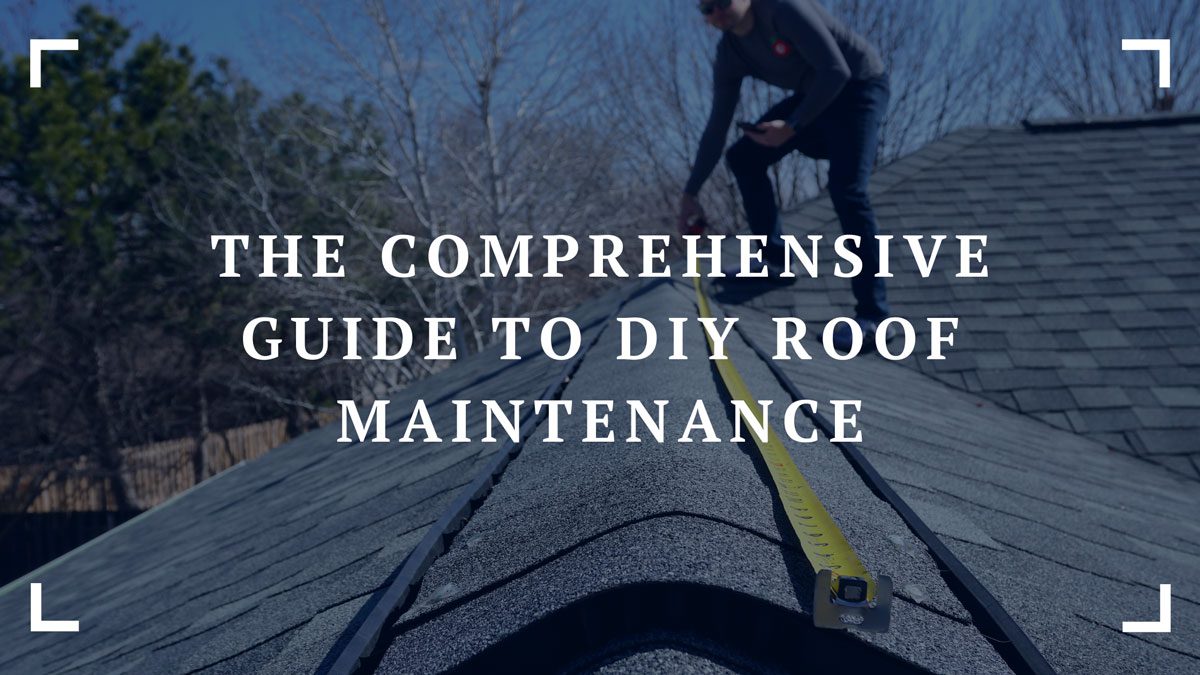Your roof is more than just a protective covering; it’s a crucial element of your home’s structural integrity and overall curb appeal. Regular maintenance is key to ensuring your roof remains in top condition, protecting your home from the elements and potentially costly repairs.
In this comprehensive guide, we’ll delve deeper into the world of DIY roof maintenance, covering everything from inspections to repairs and beyond.

The Importance of Regular Inspections
Regular inspections are the cornerstone of effective roof maintenance. You can prevent small problems from escalating into major headaches by catching issues early. Here’s how to conduct a thorough inspection:
- Interior Inspection: Start inside your home. Look for signs of water damage on ceilings and walls, such as water stains or peeling paint. Check for any areas where daylight might be visible through the roof boards, indicating possible leaks.
- Exterior Inspection: Move outside and inspect your roof’s surface. Use binoculars if needed to safely examine the condition of your shingles. Look for missing, damaged, or curled shingles, as well as any signs of moss or algae growth, which can indicate moisture buildup.
- Roof Deck Inspection: If it’s safe to do so, climb onto your roof and check the condition of the roof deck. Look for sagging areas, signs of rot, or damaged flashing around chimneys, vents, and skylights.
- Gutter Inspection: Don’t forget to inspect your gutters for debris buildup, which can prevent proper drainage and lead to water damage. Ensure they are securely attached and free of rust or corrosion.
DIY Maintenance Tips for a Healthy Roof
Once you’ve completed your inspections, there are several maintenance tasks you can perform yourself to keep your roof in top shape:
- Clean Gutters and Downspouts: Remove leaves, twigs, and other debris from gutters and downspouts to prevent clogs and ensure proper water flow.
- Trim Overhanging Branches: Trim back any tree branches that hang over your roof to prevent damage from falling limbs and reduce the risk of moss or algae growth.
- Remove Moss and Algae: Use a soft brush or low-pressure washer to remove moss and algae growth. Avoid using high-pressure washers, as they can damage shingles.
- Replace Damaged Shingles: If you find damaged or missing shingles during your inspection, replace them promptly to prevent water infiltration and further damage.
- Seal Leaks: Use roofing cement to seal any small leaks or gaps around flashing, vents, or chimneys. For larger repairs, consider hiring a professional roofer.
- Check and Repair Flashing: Inspect the flashing around chimneys, vents, and skylights for signs of damage or deterioration. Repair or replace flashing as needed to maintain a watertight seal.
- Ensure Proper Ventilation: Adequate attic ventilation is crucial for preventing moisture buildup and extending the life of your roof. Check vents and fans to ensure they are clear and functioning properly.
Knowing When to Call a Professional
While many roof maintenance tasks can be done DIY, some issues are best left to the professionals. Consider hiring a roofing contractor if you encounter any of the following:
- Extensive roof damage or leaks
- Severe storm damage
- Coming to the end of your roof’s expected lifespan
- Safety concerns about working at heights
Additional Factors to Consider for DIY Roof Maintenance
- Weather Conditions: Plan your maintenance during dry weather to avoid accidents and ensure that repairs are effective. Working on a wet roof can be dangerous and may not allow materials to adhere properly.
- Safety Equipment: Use appropriate safety gear, such as harnesses, gloves, and non-slip shoes, when working on the roof. Ensure your ladder is secure and placed on stable ground.
- Material Compatibility: Use materials compatible with your roofing system. For example, to ensure a proper seal, use roofing cement or sealant recommended by the manufacturer.
- Proper Waste Disposal: Responsibly dispose of debris and old roofing materials. Improper disposal can lead to environmental pollution and may be against local regulations.
- Local Regulations: Familiarize yourself with local regulations regarding roof maintenance, especially if you plan on making significant repairs or modifications.
- Wildlife Prevention: Install barriers or take other measures to prevent wildlife, such as birds or rodents, from nesting or damaging your roof.
- Insurance Coverage: Check your homeowner’s insurance policy to understand what types of roof maintenance and repairs are covered. Some policies may require professional installation or repairs for coverage.
- Professional Consultation: If you’re unsure about the condition of your roof or how to proceed with maintenance, consider consulting with a roofing professional. Professional roof inspection can save you time and make repair much easier.
- Regular Maintenance Schedule: Establish a regular maintenance schedule to ensure your roof stays in good condition year-round. Regular inspections and minor repairs can prevent major issues down the line.
- Documentation: Keep records of your roof maintenance, including inspection reports, repairs, and any professional consultations. This can be helpful for insurance claims and future maintenance planning.
By considering these additional factors, you can ensure that your DIY roof maintenance efforts are safe, effective, and compliant with regulations.
The Tools You’ll Need
For DIY roof maintenance, you’ll need a set of tools to ensure the job is done safely and effectively. Here’s a list of essential tools:
- Safety Gear: To prevent accidents, invest in a sturdy ladder, harness, non-slip shoes, gloves, and protective eyewear.
- Roofing Hammer: Also known as a roofing hatchet, this tool is designed to remove old nails and install new ones when replacing shingles.
- Utility Knife: Use a knife with a sharp blade to cut shingles, roofing felt, and other materials during repairs or installations.
- Roofing Nails: Stock up on roofing nails compatible with your roofing material, preferably galvanized or stainless steel, for durability and rust resistance.
- Roofing Adhesive: Essential for sealing gaps around flashing, vents, and chimneys to prevent leaks.
- Roofing Sealant: To maintain the integrity of the roof surface, use silicone or acrylic roofing sealant to fill cracks, gaps, and holes.
- Roofing Shovel or Rake: These tools are useful for removing debris, moss, or algae from the roof surface without damaging the shingles.
- Gutter Scoop: A gutter scoop can help remove debris efficiently when cleaning gutters.
- Wire Brush: Use a wire brush to remove rust or clean surfaces before applying sealant or adhesive.
- Caulk Gun: Needed to apply roofing sealant or adhesive in a controlled manner.
- Safety Harness: A safety harness is essential for working on steep roofs, preventing falls and injuries.
- Binoculars: Binoculars can help you inspect your roof from the ground, allowing you to spot potential issues without climbing onto the roof.
- Extension Ladder: Useful for reaching high areas of the roof safely.
- Broom or Blower: Use a broom or blower to remove leaves, branches, and other debris from the roof surface.
- Measuring Tape: Handy for measuring materials and ensuring accurate cuts during repairs or installations.
Conclusion
Regular DIY roof maintenance is essential for protecting your home and ensuring your roof lasts for years to come. By following these tips and staying vigilant for signs of damage, you can keep your roof in top condition and enjoy a safe and comfortable home.

